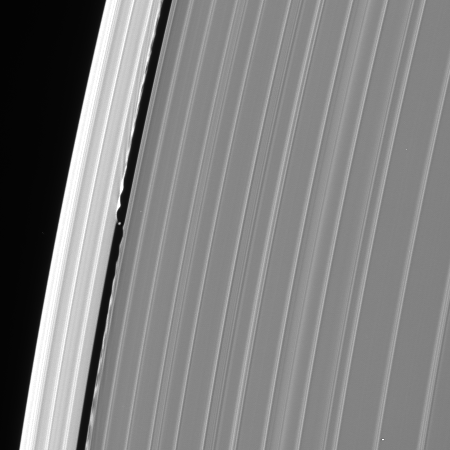Europe’s Trace Gas Orbiter circling Mars gets images of interstellar Comet 3I/Atlas
Using Europe’s Trace Gas Orbiter (TGO) that is in orbit around Mars, engineers have obtained images of the interstellar Comet 3I/Atlas.
The image to the right is a screen capture of the last image in a movie they created from all the pictures. I have added the arrow to indicate the comet, which underlines the fact that these images really don’t tell us that much about the comet itself. It is hardly more than a few pixels across, with no real detail resolved. However, the data has still been found useful.
Until September, figuring out the location and trajectory of 3I/ATLAS relied on Earth-based telescopes. Then between 1 and 7 October, ESA’s ExoMars TGO turned its eyes towards the interstellar comet from its orbit around Mars. The comet passed relatively close to Mars, approaching to about 29 million km during its closest phase on 3 October.
The Mars probe got about ten times closer to 3I/ATLAS than telescopes on Earth and it observed the comet from a new viewing angle. The triangulation of its data with data from Earth helped to make the comet’s predicted path much more accurate.
While the scientists initially anticipated a modest improvement, the result was an impressive ten-fold leap in accuracy, reducing the uncertainty of the object’s location.
All the data continues to confirm that 3I/Atlas is nothing more than comet, though like all comets unique in its own way. This refined location data will also improve the on-going observations of Europe’s Jupiter probe Juice, presently on its way to Jupiter and in the best position to see 3I/Atlas.
Using Europe’s Trace Gas Orbiter (TGO) that is in orbit around Mars, engineers have obtained images of the interstellar Comet 3I/Atlas.
The image to the right is a screen capture of the last image in a movie they created from all the pictures. I have added the arrow to indicate the comet, which underlines the fact that these images really don’t tell us that much about the comet itself. It is hardly more than a few pixels across, with no real detail resolved. However, the data has still been found useful.
Until September, figuring out the location and trajectory of 3I/ATLAS relied on Earth-based telescopes. Then between 1 and 7 October, ESA’s ExoMars TGO turned its eyes towards the interstellar comet from its orbit around Mars. The comet passed relatively close to Mars, approaching to about 29 million km during its closest phase on 3 October.
The Mars probe got about ten times closer to 3I/ATLAS than telescopes on Earth and it observed the comet from a new viewing angle. The triangulation of its data with data from Earth helped to make the comet’s predicted path much more accurate.
While the scientists initially anticipated a modest improvement, the result was an impressive ten-fold leap in accuracy, reducing the uncertainty of the object’s location.
All the data continues to confirm that 3I/Atlas is nothing more than comet, though like all comets unique in its own way. This refined location data will also improve the on-going observations of Europe’s Jupiter probe Juice, presently on its way to Jupiter and in the best position to see 3I/Atlas.
















